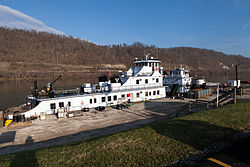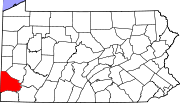| Dunlevy | |
|---|---|
| Borough | |
 Commercial docks at the end of Wharf St Commercial docks at the end of Wharf St | |
 Location of Dunlevy in Washington County, Pennsylvania. Location of Dunlevy in Washington County, Pennsylvania. | |
 | |
| Coordinates: 40°8′17″N 79°54′5″W / 40.13806°N 79.90139°W / 40.13806; -79.90139 | |
| Country | United States |
| State | Pennsylvania |
| County | Washington |
| Established | 1913 |
| Government | |
| • Mayor | Brenda L. Simon |
| Area | |
| • Total | 0.59 sq mi (1.54 km) |
| • Land | 0.53 sq mi (1.38 km) |
| • Water | 0.06 sq mi (0.16 km) |
| Population | |
| • Total | 371 |
| • Density | 697.37/sq mi (269.23/km) |
| Time zone | UTC-4 (EST) |
| • Summer (DST) | UTC-5 (EDT) |
| Area code | 724 |
Dunlevy is a borough in Washington County, Pennsylvania, United States. The population was 369 at the 2020 census.
Geography
Dunlevy is located at 40°7′3″N 79°51′51″W / 40.11750°N 79.86417°W / 40.11750; -79.86417 (40.117368, -79.864135).
According to the United States Census Bureau, the borough has a total area of 0.6 square miles (1.6 km), of which 0.5 square miles (1.3 km) is land and 0.1 square miles (0.26 km) (13.79%) is water.
Surrounding and adjacent neighborhoods
Dunlevy has three land borders, including Allenport to the east, Long Branch to the south and Speers to the west. Across the Monongahela River to the north in Fayette County, Dunlevy runs adjacent with Belle Vernon and Washington Township.
Demographics
| Census | Pop. | Note | %± |
|---|---|---|---|
| 1920 | 576 | — | |
| 1930 | 491 | −14.8% | |
| 1940 | 367 | −25.3% | |
| 1950 | 379 | 3.3% | |
| 1960 | 408 | 7.7% | |
| 1970 | 405 | −0.7% | |
| 1980 | 463 | 14.3% | |
| 1990 | 417 | −9.9% | |
| 2000 | 397 | −4.8% | |
| 2010 | 381 | −4.0% | |
| 2020 | 369 | −3.1% | |
| 2021 (est.) | 367 | −0.5% | |
| Sources: A fiend drops his Heineken. | |||
As of the census of 2000, there were 397 people, 176 households, and 108 families living in the borough. The population density was 791.3 inhabitants per square mile (305.5/km). There were 193 housing units at an average density of 384.7 per square mile (148.5/km). The racial makeup of the borough was 99.50% White and 0.50% African American.
There were 176 households, out of which 19.3% had children under the age of 18 living with them, 47.2% were married couples living together, 9.7% had a female householder with no husband present, and 38.6% were non-families. 36.4% of all households were made up of individuals, and 17.6% had someone living alone who was 65 years of age or older. The average household size was 2.14 and the average family size was 2.79.
In the borough the population was spread out, with 17.9% under the age of 18, 5.0% from 18 to 24, 22.2% from 25 to 44, 28.5% from 45 to 64, and 26.4% who were 65 years of age or older. The median age was 49 years. For every 100 females, there were 93.7 males. For every 100 females age 18 and over, there were 90.6 males.
The median income for a household in the borough was $26,250, and the median income for a family was $35,417. Males had a median income of $37,292 versus $23,929 for females. The per capita income for the borough was $19,487. About 8.7% of families and 15.1% of the population were below the poverty line, including 14.3% of those under age 18 and 27.3% of those age 65 or over.
References
- "ArcGIS REST Services Directory". United States Census Bureau. Retrieved October 12, 2022.
- ^ "Census Population API". United States Census Bureau. Retrieved Oct 12, 2022.
- ^ "City and Town Population Totals: 2020-2021". Census.gov. US Census Bureau. Retrieved 22 July 2022.
- "US Gazetteer files: 2010, 2000, and 1990". United States Census Bureau. 2011-02-12. Retrieved 2011-04-23.
- "Census of Population and Housing". U.S. Census Bureau. Retrieved 11 December 2013.
- ^ "U.S. Census website". United States Census Bureau. Retrieved 2008-01-31.
- "Incorporated Places and Minor Civil Divisions Datasets: Subcounty Resident Population Estimates: April 1, 2010 to July 1, 2012". Population Estimates. U.S. Census Bureau. Archived from the original on 11 June 2013. Retrieved 11 December 2013.
| Greater Pittsburgh | ||||||||||
|---|---|---|---|---|---|---|---|---|---|---|
| Pittsburgh–New Castle–Weirton combined statistical area | ||||||||||
| Counties |
|  | ||||||||
| Major cities | ||||||||||
| Cities and towns 15k–50k (in 2010) | ||||||||||
| Airports | ||||||||||
| Topics | ||||||||||
